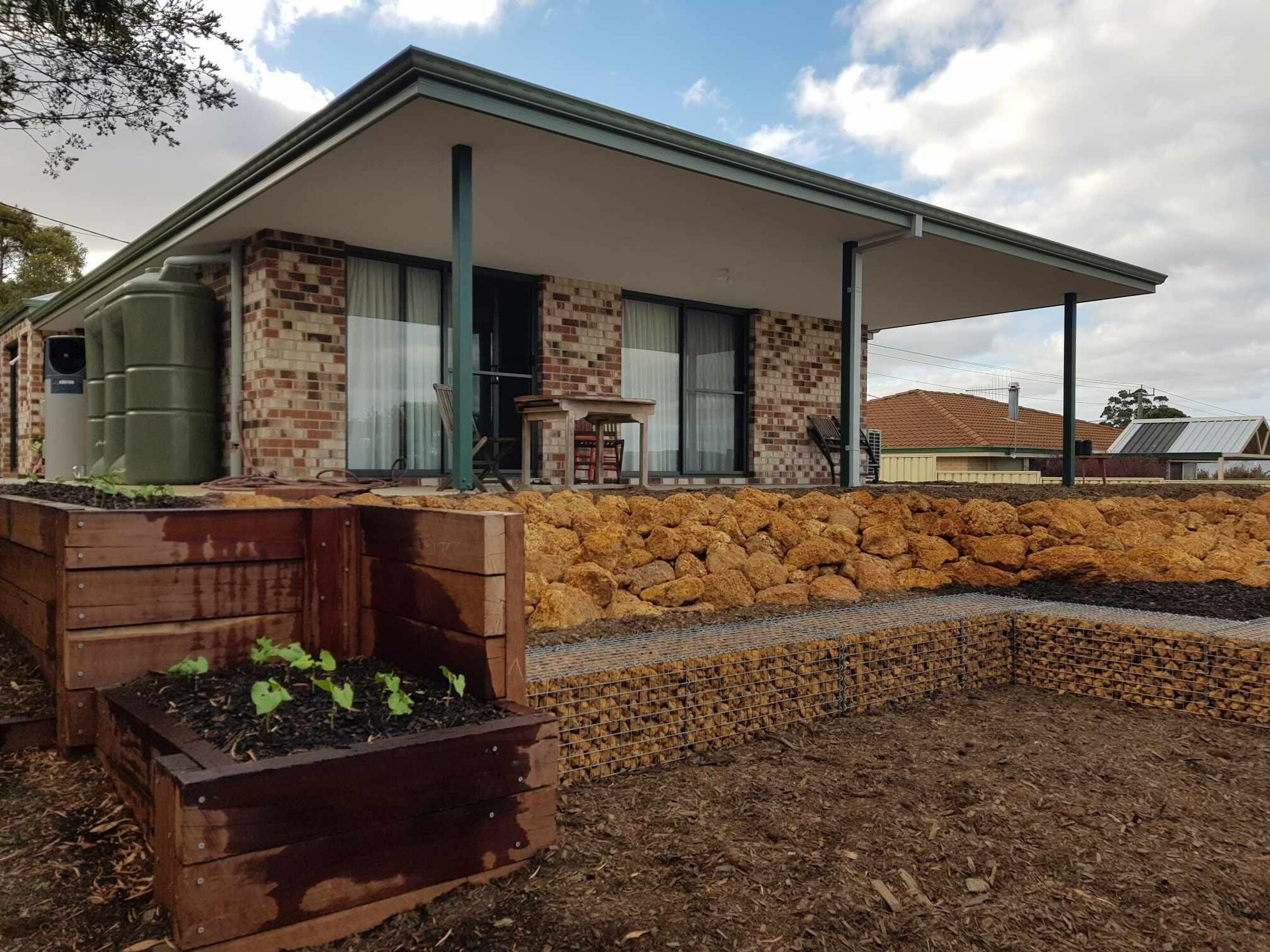I (Michael) was recently very fortunate to have had the opportunity to build my own house and like many others in my generation, it was mostly because I had financial support from the “bank of Mum and Dad.”
Of course, the fact that being a homeowner is now a pipedream for so many people is wrong on so many levels. This is because Australia has become a neo-liberal society on steroids that relies heavily upon real estate and housing speculation. You can read about why the housing crisis is here to stay but how, with major systemic change (something that we need to tackle the climate and ecological emergency) we can start to claw back control from the investors, developers, and speculators here.
So due to having family support, and after years of having lived in often substandard accommodation, I was lucky (unlike many others) to finally obtain the housing security that I so desperately needed.
Finding a place to live
Like an increasing number of Australians, I migrated from one of the large state capitals (Melbourne) to a regional town (Albany) which in part would enable me to escape the rapidly worsening rental market and find somewhere that is affordable to purchase. Finding a suitable place to live in Albany was the next task.
Unfortunately, there was very little on the market in 2022 that was within my price range that wasn’t a fibro asbestos house in need of a lot of renovation. Because I was renting a crumbling asbestos house at the time, I was keen to not have to face the stuff again in a hurry (Mark had also just spent over four grand getting an asbestos shed and porch removed on a unit that he was renovating).
It was also at a time when large parts of Eastern Australia were locked-down due to the Covid pandemic. While WA’s border was closed, there was talk of house and land prices increasing sharply as soon as the border reopened. That combined with building supply issues and a lack of tradies meant it was an edgy time. So, I decided that it was important to purchase a piece of land as soon as possible and look towards getting a small house built at the earliest opportunity. With hindsight, this was just as well because the cost of housing and construction has increased massively in the last two years. The downside however, is that due to feeling rushed, I didn’t have the time or opportunity to do enough consultation and preparation in order to get the best overall outcome. Also, this meant that I left a lot of the decision making to the building company, which with hindsight, I would not have done. But more on that later.
I managed to find a weed infested infill block that is about 700 metres square in size, located between two existing houses that appear to have been built in the early 1990s. Building here would finish the street off and the idea was that by building a smaller house, I would have plenty of room to plant a native/permaculture garden with substantial trees along the fence line.
Figure 1: The vacant block

Sadly, the budget did not allow for a bespoke house to be built from scratch and time was also of the essence. The land had already set me back $155,000, so the decision was made to build a project home with an established large building company and adapt it as much as possible to make it smaller and greener.
I ended up choosing Country Builders because rightly or wrongly, I felt that they would deliver a better-quality product. This was in part because they provide a ten-year guarantee on new homes. They also appeared to get their houses built quickly, at a time when the length of time to build new houses seemed to be increasing. Crucially Country Builders also appeared to be too big and too well-established to go under in an era when many building companies are going broke.
Choosing the design
Before approaching Country Builders, I spent some time researching passive house design and discussing options with local permaculture enthusiasts. This included a ‘tour’ of my block from students who were undertaking a course at the local TAFE. This, combined with some inspiration that I took from small and tiny houses that I had seen during my time in Victoria, helped to inform my initial draft of the house design.
So, I met with Country Builders to explore my ideas, and agreed that ‘The Brisbane’ was the most appropriate choice from their catalogue of options. But it would nevertheless require several significant modifications. The first modification was to make it into a single garage house. The second was to rearrange the floor plan significantly so that the living area would now face North and the sleeping areas would face south. It was important to me to have a north facing, open plan design which maximised interactivity with the outdoor space, so I also removed the theatre room from the original plan and compensated it with a larger veranda at the back. It now meant that it was wide enough to span the width of the house.
At this stage Mark joined-in with the design process.
It was then decided to widen the living area slightly to compensate for the removal of the theatre room. We also decided upon a weatherboard indoor feature wall as a nod to a more traditional WA aesthetic, especially as there is also some weatherboard on the façade.
After some discussion the decision was made to construct the house from a more traditional brick rather than the square concrete blocks that are currently popular but do not appear to age well.
These cosmetic changes added to the budget, but we felt that they were necessary in order to give the house some individuality, character and connection to the streetscape. It was also decided to pay extra to have paving laid all around the house and to increase the width of the driveway in order to accommodate two cars side-by-side, especially as we had downsized the garage from a double to a single.
Figure 2: The decision to choose a more traditional brick added to the cost of the build (left)
Adding bamboo floors and an internal weatherboard wall also added quite a lot more to the cost of the build (right) but it made the house feel more homely than the plasterboard and vinyl floor alternative.
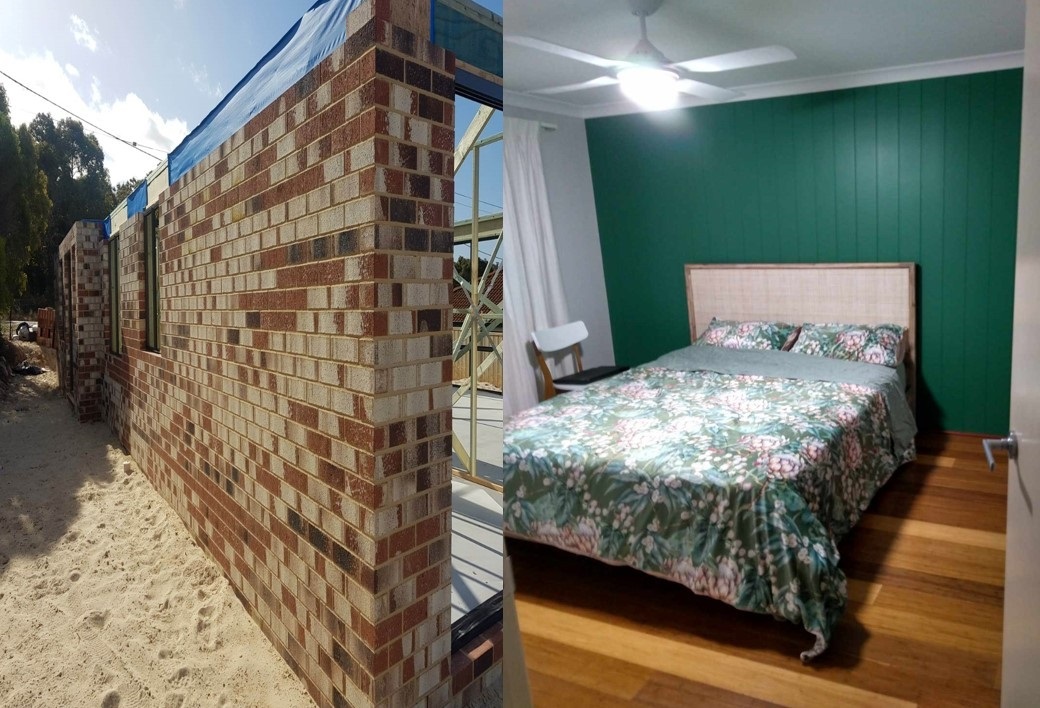
Greening the build
I soon realised that Country Builders was not particularly sympathetic to me wanting to make the design and build as green as possible and I was told upfront that: “if you want to be green, don’t build a house.”
Obviously, the greenest thing that anyone can do is to not build a house at all; that is unless it is built out of recycled tyres and carbon absorbing hempcrete, but sadly this was not an option for me in Albany at this time. Due to Australia’s massive housing crisis and rapid population growth, the reality is that a large number of houses will need to be constructed quickly as a consequence of decisions made by the Federal Government. And the majority of this housing construction will be undertaken by project builders.
So, the main onus has to be on building companies like Country Builders who construct project homes. Therefore, it is important that they be open to adapting their designs and their approach to the construction process in order to create increasingly more sustainable buildings. Bearing in mind that construction is responsible for between twenty and forty percent of all emissions, and the fact that the climate catastrophe is accelerating, everyone working in construction has a massive obligation to make it greener.
So, we had to decide where to invest the limited budget that we had left over in order to make the build greener. Because apart from making the house smaller, all green additions would come at greater expense.
A huge component of building more sustainably is ensuring that you have the best quality fixtures and fittings within your budget so that you do not have to rip stuff out and replace it down the track. One thing that we learned is not to rely upon the building company to choose the best products, so you will need to scrutinise all the proposed fixtures and fittings. For example, we requested a cistern sink toilet, in part to save water (also because they still build houses in WA without putting wash basins in toilets - which is strange) and this felt like a clever way of getting round that. We should however have chosen the model of toilet ourselves because the one that was eventually installed is impractical and difficult to use. It is a pity because there are some good models out there, so it was a missed opportunity.
Country Builders were also more than happy to install a heat pump hot water system (we still have a long way to go before heat pump hot water systems are the default option). However, it was installed directly outside the second bedroom. While the noise from heat pumps is usually not an issue, it can be an issue when it is located directly outside a bedroom window.
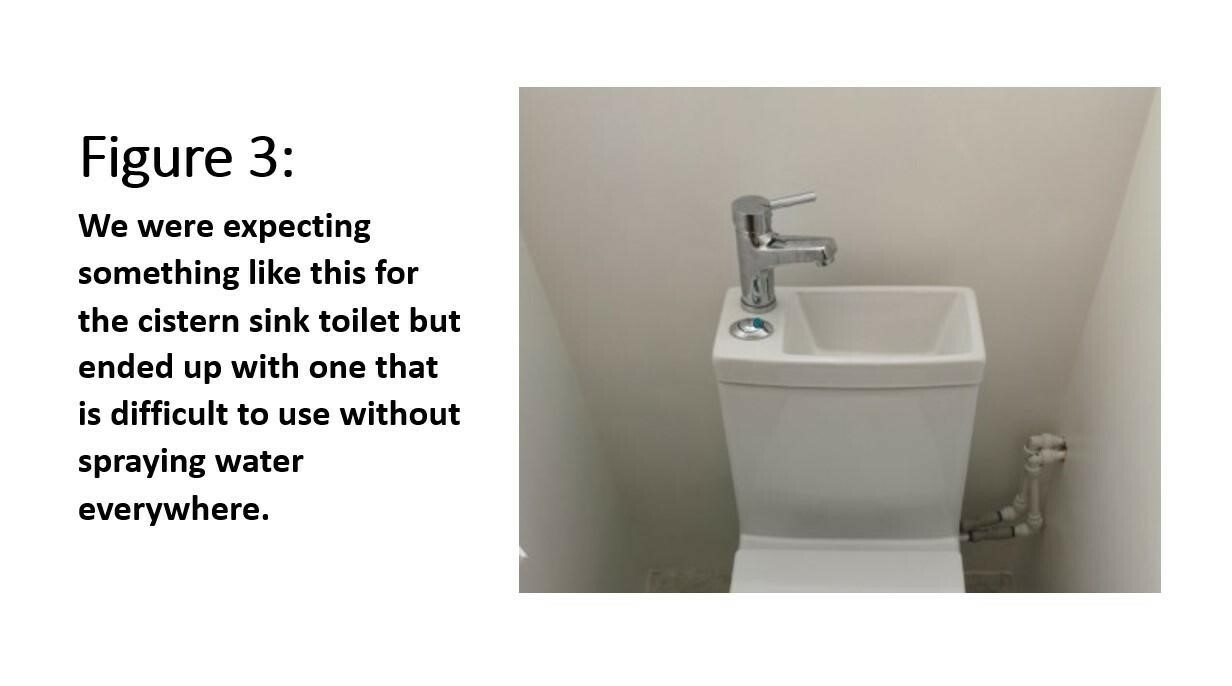
The rational decision would have been to locate it next to the kitchen at the other side of the house. However, this would have meant changing the design to make it fit. With hindsight, more effort should have been made on our part to ensure that we chose a better-quality quieter model.
As a result of this oversight, it is generally necessary to have the window shut when sleeping in the second bedroom, which is unfortunate. So, it is important to think about the location of the heat pump and to direct the building company accordingly. You cannot expect the building company to sit down with you and say ‘look, we are going to place the heat pump directly outside the bedroom window, so you might want to pay a bit extra in order to get one that makes virtually no noise’. It just won’t happen. Despite this we are optimistic that we can reprogram the heat pump to only hum during the day. Right now, it is probably programmed to do its work when electricity is off-peak but the rooftop solar system that we plan to install down the track will hopefully mean that it will do its charging during daylight hours.
With hindsight we would also have asked that the heat pump be located on a slab so that it is elevated above ground level in order to give it a chance of having the longest possible lifespan, especially as heat pumps, like all green technology, have a lot of upfront carbon emissions embedded within them.
Regarding longevity, the water in Albany is very hard so we were advised to install a water softener in order to lengthen the lifespan of the heat pump and other water related fixtures, which is what we did. This resulted in the tap water being a little salty, but we also took the opportunity to install a reverse osmosis water filter under the sink for drinking water, so it is not an issue. The other reason for installing the filter is because Albany water is pretty bad for a number of reasons.
As well as the cistern flush and heat pump system, we decided to install a 1,500-litre rainwater tank, which can also be connected to the laundry. With hindsight, we would have had a second water tank installed on the other side of the house in order to provide more water security at a time when the climate is changing, and Albany is literally running out of water.
Another major greener addition that we decided upon was to have bamboo floors as opposed to the vinyl option that Country Builders was putting pressure on us to have. This is a decision that we do not regret but they do scratch easily, so all furniture needs to be padded underneath and it needs to be a shoes-off house, which is fine by us. But it is worth it.
There were also a number of additions that we had to ask for as we thought that they are a given, such as ceiling fans. Of course, adding ceiling fans massively reduces our reliance upon air conditioning. Asking for this kind of thing is something that can be overlooked when you have a lot of upfront decisions to make very quickly when starting a new build.
One thing that we did overlook was the absence of a screen door in front of the front door on the plan. We assumed that it would have one as all the other doors and windows had screens. This means that if we want to cool the house down in the evening with a through draft by opening the front door and the back door, we have to accept that there is a clear path for the mosquitos to get in. Again, do not expect the building company to sit down with you and suggest ceiling fans and front screen doors, even though their addition could do a lot to save on energy consumption over the lifetime of the house.
We were also surprised that we had to ask for the home to be all-electric, even though the street is not connected to the gas mains. The default option for Country Builders is to install bottled gas. While we would like to see all new homes be made all-electric, as is now the case in Victoria, there should at the very least be some discussion with the client regarding the option to go all-electric rather than the default option always being gas and electric.
We also had to intervene to prevent the installation of manufactured stone benchtops in the kitchen. This was more than a year before the ban, but the health impact of installing these benchtops was very known to the industry at the time. There was quite a bit of pressure on us to install them, possibly because they had stockpiles of the stuff. By choosing vinyl laminate instead, we saved money and with proper care, they will easily be as durable as the rest of the laminate chipboard kitchen.
Modifications we should have made and the perils of building on a sloping block.
Because we were thinking about making a lot of modifications in a short period of time, we put less attention into the layout of the kitchen itself, particularly regarding storage space. Had there been more time, we would have scrutinised the kitchen layout much more in order to get a better outcome. We were surprised just how little cupboard space and work surface there was in the finished kitchen. When you consider the space needed for a chopping board, kettle and toaster as well as an area to stack dishes, there is very little room left over for food preparation. So too for storage. With hindsight we would have widened the kitchen to allow for extra cupboard space and another metre of workbench. This might not sound like much, but it would have made a huge difference.
As mentioned before, it was important for us to build a smaller house. Australia has some of the largest houses in the world. However, for the sake of adding an extra half metre in the right places, you can achieve a lot more grace while still having a small house. With hindsight we would not only have widened the kitchen by half a metre, but also the second bedroom, making it much more comfortable to sleep two people.
Also with hindsight we would have, if possible, added an extra half metre to the ensuite shower room. This would have made it much less claustrophobic, so that you could get out of the shower and dry yourself without smashing your elbows against the door. It would also allow space for a chair to place your clothes while showering. Making the ensuite larger would have resulted in lengthening the house by half a metre, which would also have given us a slightly larger living area (this would have been good, especially, as the theatre room had been removed from the design).
But while widening the house slightly in two places would have been easy, lengthening it would have been more problematic in this case, because it is a sloping block. The distance between the ground floor of the house and the ground outside is already at two metres at the bottom left corner.
Building a project home on a sloping block adds a new level of complication, especially when there is little communication regarding how best to go about this. We had suggested that the back half of the house be split level or constructed on stilts but that was quickly dismissed by Country Builders. We are not sure whether this is simply because it is impractical, or whether it is something that they simply do not do, but at the very least there should have been some discussion about the implications of building on a sand-pad on a sloping block. For example, being given the option to construct retaining walls upfront before the build so that the sand-pad could be compacted up to those walls. This would have saved a lot of wasted sand that had to be dug out and trucked off-site as part of a much more complex and difficult landscaping project that required retaining walls to be constructed after the fact.
Had we built retaining walls upfront, we would have had the option to have a much shorter sand pad (and therefore a shorter retaining wall at the back) as the veranda could easily have been built on stilts, encapsulating the back retaining wall beneath it. This would have allowed for a larger back garden or at least the option to lengthen the house slightly as discussed earlier.
This would of course all have come at considerably more cost, but it turned out to cost an additional thirty thousand to properly landscape along the edge of the entire sand-pad after the build was completed. We were very lucky that there was a landscaper who was available to do this almost as soon as the build was completed as many people are having to wait for a year. We went for a mixture of rocks and gabions and he did a great job under unenviable circumstances.
So much more discussion and openness to new ideas and options would have been great but sadly, Country Builders tended to adopt more of a ‘naysayer’ approach. Being new to the game meant a lack of self-assuredness on our part, which combined with the desperation to get the house built quickly, meant that with hindsight, we should have been more assertive with them. We need assertive clients to push construction companies to become much more sustainable. If you are assertive with Country Builders and know what to ask about and look for, they should generally be accommodating and they will deliver a good result.
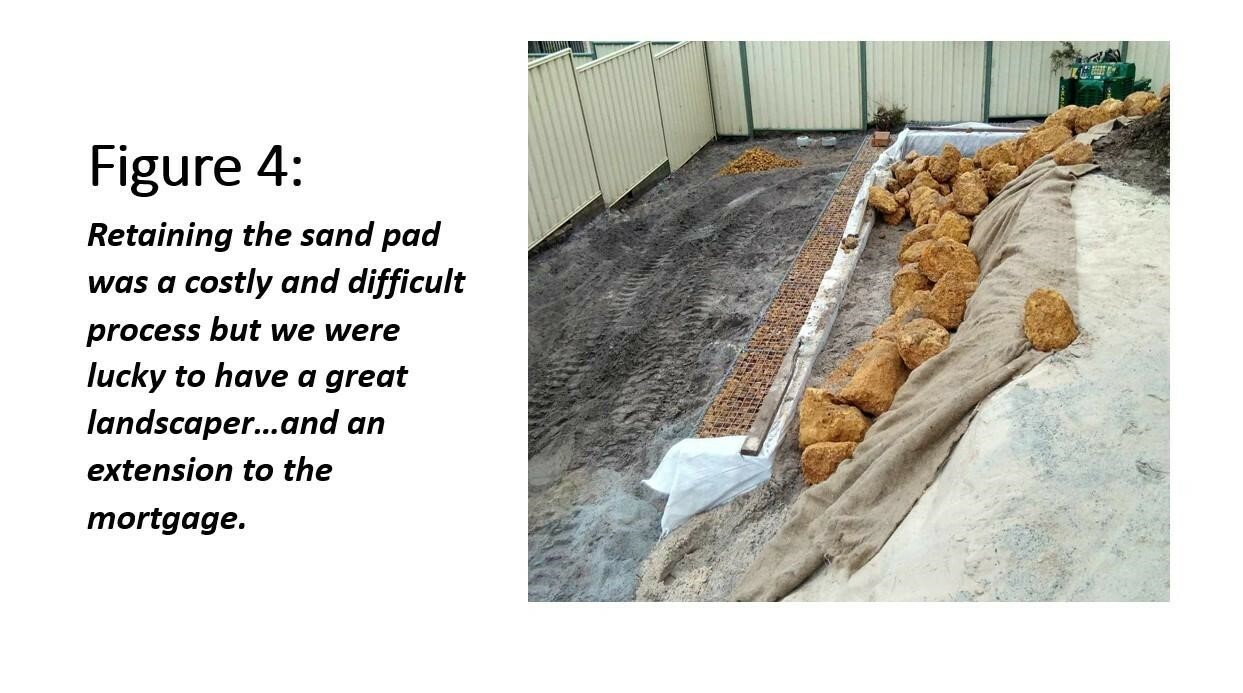
While our attempts at having a part sand-pad half stilt house did not happen, we did get some success by working with Country Builders to get the positional layout of the house correct. This has resulted (to date) in an outcome where the house has so far 'got away’ without having double glazing etc.
Some substantial reworking of the plans occurred here including locating the house more towards the south side of the block to allow winter sun to enter from the north. We also relocated the bedrooms to the south side with the living and kitchen areas being repositioned to be north facing. A trellis was also installed on the north perimeter of the house where passionfruit vines will be planted to make most use of the sun and to provide some shade during summer. The front office room, which faces east, gets blasted by the afternoon summer sun. A mulberry tree in front of the window will hopefully alleviate this issue, once the front garden is established. It would however, with hindsight, be nice to have had a small veranda at the front of the house to compensate for the lack of eaves in that position.
Figure 5: A front looking more like this might have helped.
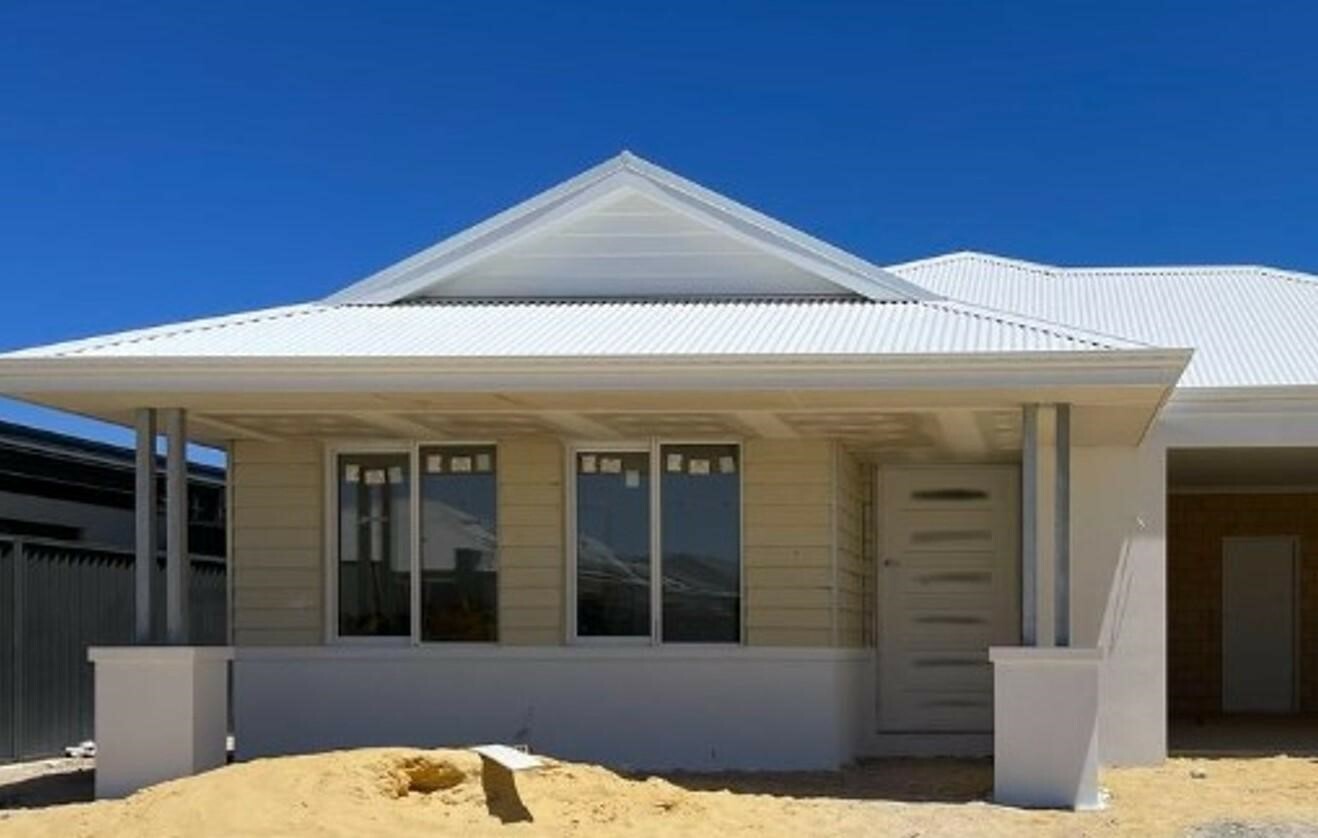
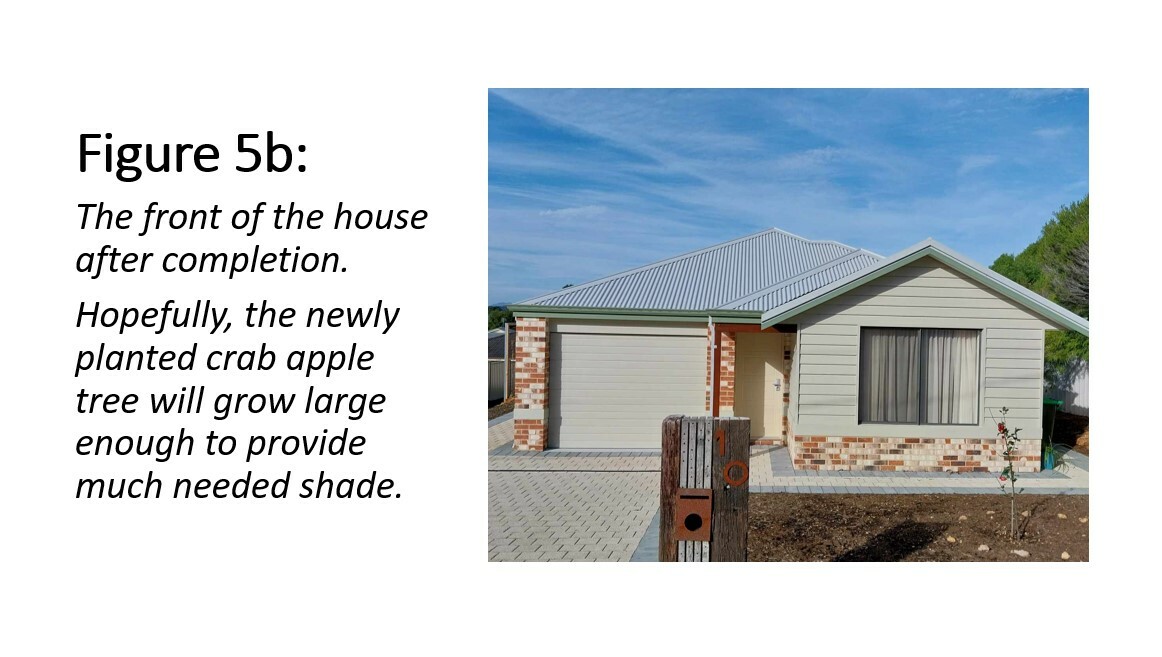
Conclusion
Building with a company such as Country Builders can be a positive experience, if you know up-front that it is ok to be constructively assertive with them. While this blog may sound like a list of First World problems and it really is, we must take every opportunity to improve the way that we build, because if we must do it, we may as well do the best possible job that we can. Especially as we have created a society where much more home building is going to be required on an ongoing basis, at least until we hit the next stage of limits-to-growth. Crucially whenever construction does happen, we need to work to ensure that the construction process and outcome is much more sustainable.
Small changes such as reducing construction waste (and there was a lot on this build, but we did rescue quite a bit from the builder’s skip) installing ceiling fans and well installed heat pumps in the right location are as important as anything else.
If anyone reading this is interested in building a similar designed house, especially in WA, especially with Country Builders, please contact us, as we would be happy to share plans and show you round what we have built. The greatest legacy of this project would be for someone to actually build an improved version.
Figure 6: The design we went with and the adapted design that we would go with today if we had our time again.

The areas shaded in yellow are the places where we would widen and lengthen the house. The areas shaded in purple and blue highlight a widened walk-in wardrobe and ensuite made possible by lengthening the house.
Figure 7: The house after landscaping taken from the rear.
